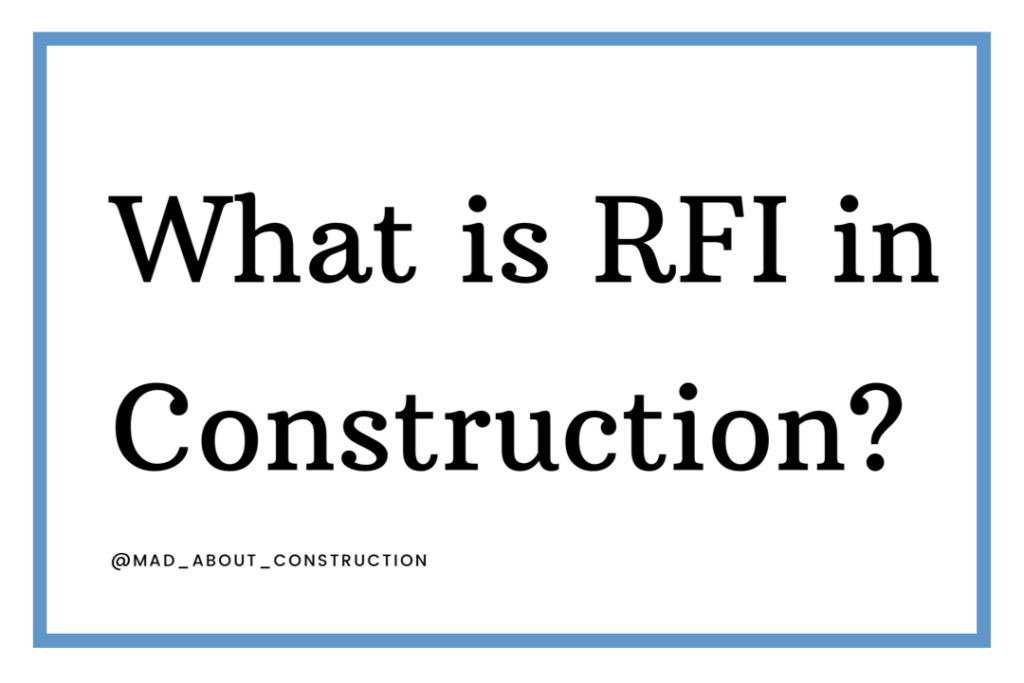Hello Friends, Welcome to my blog Mad About Construction. My name is Dipak Varsani and I am the author of madaboutconstruction.com. I am a Civil Engineer by profession and I started my engineering journey as a site engineer.
In this blog, we will look into What is RFI;
- What is RFI in Construction?
- Who can raise an RFI in Construction?
- Sharing the RFI in Construction projects?
- How to Write an RFI in Construction?
- What are the important details to be filled in RFIs?
- Download free RFI templates.
1. What is RFI in Construction?

The full form of RFI is Request for Information. A Request for Information is a standard process in construction to collect information in writing. Writing RFI and collecting the missing information or data is very important for good project management, and the Contractor should follow it to minimise conflicts and issues.
Construction documentation is the skeleton of any construction project. RFI is a vital construction document that assists in collecting the information from the authorised party or team in the construction project. RFI can also be used in other areas outside of construction.
The missing information can also be requested in the form of a letter, but this might be not easy to track as it can get mixed with other matters. The list of unresolved RFIs can be raised in a meeting, or an RFI reference can be used as a notification to advise on the delay of the project progress or completion caused by the delay or no-response to the RFI.
2. Who can raise an RFI in Construction?
It depends on the nature of the contract. Anyone involved in the construction project can raise an RFI to get the missing information or to get clarification. An RFI can be raised if any party involved in the contract requires more information or needs clarification on the terms stated in the contract or has a query relating to the drawing, or has a specification relating query.
In short, RFI is not only limited to be useful to the contractor to communicate with the engineer, architect, consultant, project manager, any subcontractors, consultants or client but it can be used by anyone involved in the project by going through the correct procedure. The sole purpose of an RFI is to seek any missing information or confirmation of unspecified details.
Usually, the contractor or subcontractor writes an RFI to the relevant party, be it the architect, the engineers, the project manager, another subcontractor, any consultants, or the client. In most cases, the contractor writes an RFI to the project manager in a specific format, and then the project manager forwards it to the relevant party. The response received by the project manager is then forwarded back to the contractor.
For example, if you have received information from the project manager instructing you to start producing a particular construction element and the information received is either not sufficient or clear enough, you can write an RFI to the project manager.
The project manager will confirm if the RFI raised is really necessary and respond or forward it to the relevant party accordingly, after checking if the issue has not already been addressed in the contract documents. Contract documents include particular and general conditions, construction standards of the relevant country, project specifications, drawings, bills of quantity (BOQ), schedules, etc.
Depending on the information required to respond to the RFI, the project manager may also have to look into whether it is to be forwarded to the architect, the engineer, the quantity surveyor or the client. For instance, if the RFI relates to something to do with the drawing, the architect would be the relevant party to assist in responding to the RFI. If the RFI is relating to something to do with BOQ, the quantity surveyor would be the relevant party to assist in responding to the RFI and so forth.
The relevant party would then assist in responding to the RFI and send the response to the project manager. The project manager will then review the response received to ensure it addresses all the queries in the RFI; once this has been completed, the project manager will forward the RFI response to the contractor.
If you are the main contractor and have a domestic sub-contractor, then the RFI will be raised to you, and you will forward it to the project manager. Then as mentioned above, once the project manager receives the response to the RFI, it will be sent to you to forward to your domestic subcontractor.
If a subcontractor has been nominated in your project, the RFI can be sent directly to the project manager, and the project manager will then follow up on the response to the RFI with the nominated subcontractor and the relevant party.
3. Sharing the RFIs in Construction Projects.
You have to determine which party will be affected by the RFI and share the RFI and its response with the concerned party. This can be done by Email or any other means of communication. By sharing the RFI and its response with the concerned party, you will avoid any conflicts in the work implementation, which may cause re-works in the project.
For example, if you need to write an RFI regarding a door, you have to copy the same RFI and its response to the client, domestic contractor, nominated contractor, etc. Not doing so may cause several repetitive works and extra costs due to poor communication. The quality of the work may also be affected.
4. How to write an RFI in Construction?
Below is an example that will help you understand the meaning of RFI (Request for Information). By referring to this example, you can learn how to write an RFI. It shows a detailed elaboration of a particular case and shows how all the points mentioned above will be applicable in a specific situation.
RFI-01:- RFI to provide the location of steps in the seawall foundation
Click on the link above to understand what RFI means in construction.
If you would like to receive more information, please subscribe to my blog Mad About Construction by writing your email and confirming the subscription email in your email inbox. You can also subscribe to my YouTube Channel. Watch this space for future updates on RFIs. If you have any questions or queries about RFI, please do not hesitate to ask by commenting in the comment box below.
5. What are the important details to be filled in the RFI?
- RFI Numbers
You should keep the RFI Number as a reference to track in the future. It becomes very easy to describe the particular RFI matter in your reports, method statements, letters, emails, and follow-up communication.
For example, If you are in the project meets and want to bring attention to outstanding RFIs, you could mention RFI numbers as a reference.
- Date and Time
Date and time is very crucial information in RFIs. If you submit your RFIs with this information, it becomes easy for you to claim the specific amount of time if the authorised team delays the response to the same. Depending on the circumstances, you can calculate the exact delay to claim as additional time.
For example, all the teams give their basic timeline for the response in some projects. If the designing team agrees that they need seven days to respond to any design-related RFIs and respond to the particular RFIs after 15 days, the delay will be eight days.
- Project Name or Reference
There are several reasons this information field will help you.
For example, if you are working on multiple projects, this information will help you to segregate your RFIs and this applies to every person and team involved in the project. Second, if any team goes for arbitration, Project Name or Reference in the documents helps support your case.
- Queries
As we talk about RFI, you should add a detailed question you want the authorised person to answer.
- Name of Company (Submitter and Reciver)
Name of the person who wants to raise an RFI with his company detail and similarly the name and detail of the company to whom he wants to raise that RFI.
5. Download free RFI templates.
There are several RFI templates available online. We design RFI templates based on the nature of the project. Each project can have a different template requirement. Sometimes the template can be changed to make your work fast and easy. People who don’t know English should use word templates as they support Grammarly while excel formats also have their own benefits.


Pingback: RFI – Practical application of an RFI (RFI Template or Sample) - Mad About Construction